How to take your PC audio experience to 11
We take a deep dive into the often unexplored area of the PC, the sound setup.
The DAC
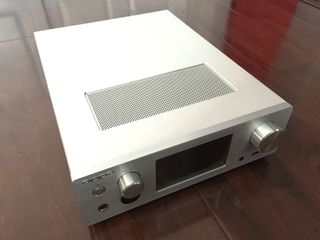
Oppo HA-1
We have a few requirements for our USB DAC. First, it must posses a good DAC chip. Second, it must posses excellent circuit and power design to deliver clean and pristine sound at 24-bit/192kHz or higher. Third, it must provide excellent headphone-driving capabilities. Fourth, it needs the necessary outputs for supporting active studio monitors. If it has a wireless option as well, that's a bonus.
The DAC that has all of the above and great engineering is the Oppo HA-1. If you haven't heard of Oppo, you'll be forgiven. The company is most famous for making excellent Blu-ray players that have features not found elsewhere, with exceptional output quality. But recently, Oppo has gotten into both the business of making USB DACs and excellent-sounding planar-magnetic headphones. Oppo's PM-3 specifically was selected by The WireCutter as its best-sounding headphones under $400.
A step up:
The other DACs we would consider include Schiit Audio's Yggdrasil and Gungnir Multibit. Both are true multi-bit DACs and both are revered by the audiophile community. The difference between the two models, according to Schiit co-founder Jason Stoddard:
- Gungnir Multibit uses four 18-bit AD DACs, as opposed to Yggdrasil’s four 20-bit AD DACs.
- Gungnir Multibit’s analog stage uses all surface-mount components, whereas Yggdrasil has some through-hole components. Both are simple, discrete JFET buffers with the same topology, though.
- Gungnir Multibit’s power supply is much simpler than the Yggdrasil, which has a pretty heroic supply, including a choke-input and discrete shunt-regulated analog supply.
- Gungnir Multibit is only available with Gen 2 USB, while Yggdrasil has the newer Gen 3 USB.
The only caveat is that both the Yggdrasil and Gungnir are discrete DACs and will require a separate amplifier if you plan to drive passive speakers, or plan to use headphones. The Gungnir Multibit and Yggdrasil are $1,249 and $2,299, respectively.
We'll be giving the Schiit Gungnir and Mjolnir 2 powered amp a closer look in an upcoming article, but if you're interested in finding out more from the community, check out head-fi.org here and here.
A closer look at the Oppo HA-1
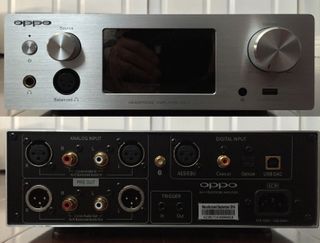
For $1,199, the Oppo HA-1 has one of the most sought-after features for a DAC: an ESS 9018 Sabre 32 DAC (PDF). This DAC can be found in some of the highest-end receivers. The ESS 9018 DAC is widely considered as the best audio DAC in the world (many consider the Analog Devices DAC in the Schiit Yggdrasil to be the king), but ESS recently announced a new flagship DAC, the 9038PRO. Both DACs support 32-bit/384kHz on all channels. The 9038PRO has an incredible DNR (dynamic range) of 140dB (129dB for the 9018) and THD+ (total harmonic distortion plus noise) rating of -122dB (-120dB for the 9018). The entire audio path from power delivery to signal conversion is equally important in supporting a good DAC. You can find small USB adapters that have the Sabre DAC for less than $70, but the audio output won't be great.
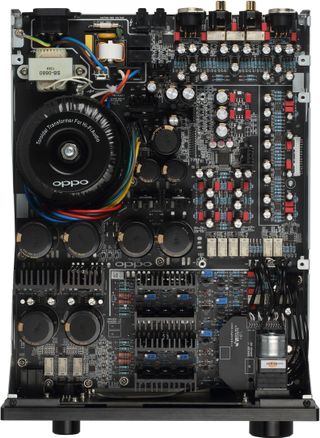
If the ESS 9018 Sabre is the heart of the HA-1, then the Class A amplifier in the HA-1 would be its soul. The sound delivered by the HA-1 is extremely clean, with a very low noise floor. Even with the volume cranked to maximum, our headphones delivered nothing but silence. While Class A amps are considered best for audio quality, they do run hot. Lesser units will rely on Class D amps, which don't run as hot, are more efficient, but introduce more noise.
The biggest gaming news, reviews and hardware deals
Keep up to date with the most important stories and the best deals, as picked by the PC Gamer team.
If you're interested in running a USB DAC, take note that the HA-1 is an asynchronous USB DAC, meaning it doesn't rely on the host computer's USB clock generator. If you're already familiar with USB DACs, sound output can be affected by poor USB clocks on the motherboard. DAC dropouts and/or strange noises when switch sampling rates are common. If you have a USB DAC and are experiencing issues, you might consider Schiit's Wyrd USB Decrapifier, which cleans up and rechecks the USB signal, virtually eliminating any problems you may have with your DAC, unless the DAC itself is going bad. We have two, and they work.
Besides being a fantastic headphone amplifier, the HA-1 is also great as a pre-amp for speakers. We like the HA-1 in particular for having both single-ended and balanced XLR outputs. Most speakers will connect to the single-ended RCA jacks, but if you're planning to use professional studio monitors, like the ones we chose, the balanced outputs will help reduce noise significantly over longer cable runs.
How does XLR balanced connections work? Using a technique called differential mode, the audio signal is carried over two separate wires with opposing polarity. The two signals cancel each other out on the receiving end (which must be differential-capable). What you're left with is just the noise signal, which is then rejected by the receiving end. With the noise signal removed, what you're left with is a clean audio signal. We made sure our entire signal path is fully balanced, with the same XLR cables through all interconnects, to ensure that the impedances are matched. If you're using headphones with the HA-1, it has support for both normal and high-gain output, and supports both headphones using 1/4-inch TRS connectors as well as balanced XLR connectors.
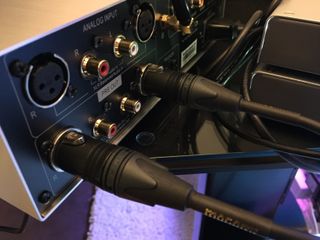
Oppo also filled the HA-1 with plenty of other useful features. Audio over Bluetooth (AptX) support is included, as well as a pure analog potentiometer for volume control. Many other DACs use a digital volume control chip to control output, which adds an additional step in the audio path. The HA-1 maintains a completely analog path from DAC to connector.

One minor complaint we have with the HA-1 is its inability to mute the pre-outs directly on the unit itself. You must use the supplied remote control to mute your speaker output if you decide to switch over to headphones. This is annoying and we hope Oppo can include it in a firmware update. If you lose your remote, you'll be unable to mute speaker output.
MEASUREMENTS
Measuring equipment:
- - Focusrite Scarlett 2i2 interface
- - Onboard audio: Realtek ALC898 7.1 channel
- - DAC: Oppo HA-1 (ESS Sabre 9018 DAC)
Onboard (BLUE) vs. DAC pre-out (GREEN), volume min
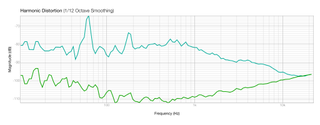
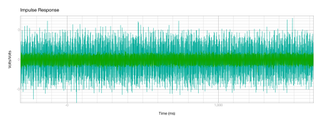
Onboard headphone out (PURPLE) vs. DAC headphone out (RED), volume min
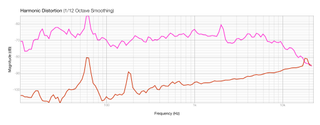
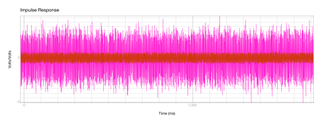
Onboard out (BLUE) vs. Onboard headphone out (PURPLE), volume min
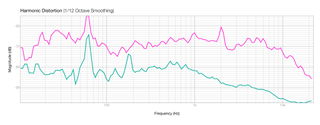
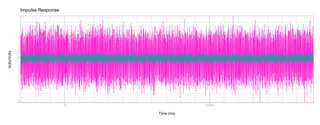
The audio output from the HA-1 is outstanding, naturally. It's clean, free of noise, and the frequency response is excellent. Compared to onboard, noise and distortion is significantly less. Keep in mind that the dB scale is logarithmic, meaning for every 3dB the perceived volume doubles. The ESS Sabre 9018 really shines in the HA-1. In terms of tonality, the sound produced by the 9018 is accurate, but if you're looking for a warmer-colored sound, the HA-1 may not be for you.
The onboard outputs, both rear jacks and headphone jacks, are completely destroyed by using an external USB DAC. The DAC has a superior low noise floor that just can't be matched by the motherboard solution, no matter how good it's shielded. There are too many factors inside your PC that can't be controlled, and the result of that show up on the analysis. There's even a stark difference between onboard rear outputs and onboard headphone jacks on the front panel. The cable that connects your motherboard's front-panel outputs to the actual jacks on your case are picking up lots of internal interference, even though they're short.
Now let's move on to choosing our speakers.
Most Popular

